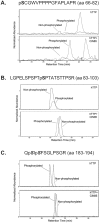Phosphorylation of human tristetraprolin in response to its interaction with the Cbl interacting protein CIN85
- PMID: 20221403
- PMCID: PMC2833206
- DOI: 10.1371/journal.pone.0009588
Phosphorylation of human tristetraprolin in response to its interaction with the Cbl interacting protein CIN85
Abstract
Background: Tristetraprolin (TTP) is the prototype member of a family of CCCH tandem zinc finger proteins and is considered to be an anti-inflammatory protein in mammals. TTP plays a critical role in the decay of tumor necrosis factor alpha (TNF) mRNA, among others, by binding AU-rich RNA elements in the 3'-untranslated regions of this transcript and promoting its deadenylation and degradation.
Methodology/principal findings: We used yeast two-hybrid analysis to identify potential protein binding partners for human TTP (hTTP). Various regions of hTTP recovered 31 proteins that fell into 12 categories based on sequence similarities. Among these, the interactions between hTTP and CIN85, cytoplasmic poly (A) binding protein (PABP), nucleolin and heat shock protein 70 were confirmed by co-immunoprecipitation experiments. CIN85 and hTTP co-localized in the cytoplasm of cells as determined by confocal microscopy. CIN85 contains three SH3 domains that specifically bind a unique proline-arginine motif (PXXXPR) found in several CIN85 effectors. We found that the SH3 domains of CIN85 bound to a PXXXPR motif located near the C-terminus of hTTP. Co-expression of CIN85 with hTTP resulted in the increased phosphorylation of hTTP at serine residues in positions 66 and 93, possibly due in part to the demonstrated association of mitogen-activated protein kinase kinase kinase 4 (MEKK4) to both proteins. The presence of CIN85 did not appear to alter hTTP's binding to RNA probes or its stimulated breakdown of TNF mRNA.
Conclusions/significance: These studies describe interactions between hTTP and nucleolin, cytoplasmic PABP, heat shock protein 70 and CIN85; these interactions were initially discovered by two-hybrid analysis, and confirmed by co-immunoprecipitation. We found that CIN85 binding to a C-terminal motif within hTTP led to the increased phosphorylation of hTTP, possibly through enhanced association with MEKK4. The functional consequences to each of the members of this putative complex remain to be determined.
Conflict of interest statement
Figures









Similar articles
-
CIN85 regulates the ability of MEKK4 to activate the p38 MAP kinase pathway.Biochem Biophys Res Commun. 2005 Dec 16;338(2):808-14. doi: 10.1016/j.bbrc.2005.10.032. Epub 2005 Oct 18. Biochem Biophys Res Commun. 2005. PMID: 16256071
-
TRAIL/MEKK4/p38/HSP27/Akt survival network is biphasically modulated by the Src/CIN85/c-Cbl complex.Cell Signal. 2013 Jan;25(1):372-9. doi: 10.1016/j.cellsig.2012.10.010. Epub 2012 Oct 23. Cell Signal. 2013. PMID: 23085457
-
Identification of a novel proline-arginine motif involved in CIN85-dependent clustering of Cbl and down-regulation of epidermal growth factor receptors.J Biol Chem. 2003 Oct 10;278(41):39735-46. doi: 10.1074/jbc.M304541200. Epub 2003 Jul 21. J Biol Chem. 2003. PMID: 12874286
-
The tandem CCCH zinc finger protein tristetraprolin and its relevance to cytokine mRNA turnover and arthritis.Arthritis Res Ther. 2004;6(6):248-64. doi: 10.1186/ar1441. Epub 2004 Oct 8. Arthritis Res Ther. 2004. PMID: 15535838 Free PMC article. Review.
-
The tandem zinc finger RNA binding domain of members of the tristetraprolin protein family.Wiley Interdiscip Rev RNA. 2019 Jul;10(4):e1531. doi: 10.1002/wrna.1531. Epub 2019 Mar 12. Wiley Interdiscip Rev RNA. 2019. PMID: 30864256 Free PMC article. Review.
Cited by
-
Multiple functions of tristetraprolin/TIS11 RNA-binding proteins in the regulation of mRNA biogenesis and degradation.Cell Mol Life Sci. 2013 Jun;70(12):2031-44. doi: 10.1007/s00018-012-1150-y. Epub 2012 Sep 12. Cell Mol Life Sci. 2013. PMID: 22968342 Free PMC article. Review.
-
Drosophila eyes absent is a novel mRNA target of the tristetraprolin (TTP) protein DTIS11.Int J Biol Sci. 2012;8(5):606-19. doi: 10.7150/ijbs.3782. Epub 2012 Apr 20. Int J Biol Sci. 2012. PMID: 22553461 Free PMC article.
-
Rapid proteasomal degradation of posttranscriptional regulators of the TIS11/tristetraprolin family is induced by an intrinsically unstructured region independently of ubiquitination.Mol Cell Biol. 2014 Dec 1;34(23):4315-28. doi: 10.1128/MCB.00643-14. Epub 2014 Sep 22. Mol Cell Biol. 2014. PMID: 25246635 Free PMC article.
-
Tristetraprolin inhibits poly(A)-tail synthesis in nuclear mRNA that contains AU-rich elements by interacting with poly(A)-binding protein nuclear 1.PLoS One. 2012;7(7):e41313. doi: 10.1371/journal.pone.0041313. Epub 2012 Jul 26. PLoS One. 2012. PMID: 22844456 Free PMC article.
-
AU-rich-element-dependent translation repression requires the cooperation of tristetraprolin and RCK/P54.Mol Cell Biol. 2012 Mar;32(5):913-28. doi: 10.1128/MCB.05340-11. Epub 2011 Dec 27. Mol Cell Biol. 2012. PMID: 22203041 Free PMC article.
References
-
- Dreyfuss G, Kim VN, Kataoka N. Messenger-RNA-binding proteins and the messages they carry. Nat Rev Mol Cell Biol. 2002;3:195–205. - PubMed
-
- Reed R. Coupling transcription, splicing and mRNA export. Curr Opin Cell Biol. 2003;15:326–331. - PubMed
-
- Blackshear PJ. Tristetraprolin and other CCCH tandem zinc-finger proteins in the regulation of mRNA turnover. Biochem Soc Trans. 2002;30:945–952. - PubMed
-
- Brewer BY, Malicka J, Blackshear PJ, Wilson GM. RNA sequence elements required for high affinity binding by the zinc finger domain of tristetraprolin: conformational changes coupled to the bipartite nature of Au-rich MRNA-destabilizing motifs. J Biol Chem. 2004;279:27870–27877. - PubMed
-
- Blackshear PJ, Lai WS, Kennington EA, Brewer G, Wilson GM, et al. Characteristics of the interaction of a synthetic human tristetraprolin tandem zinc finger peptide with AU-rich element-containing RNA substrates. J Biol Chem. 2003;278:19947–19955. - PubMed
Publication types
MeSH terms
Substances
Grants and funding
LinkOut - more resources
Full Text Sources
Molecular Biology Databases
Miscellaneous

